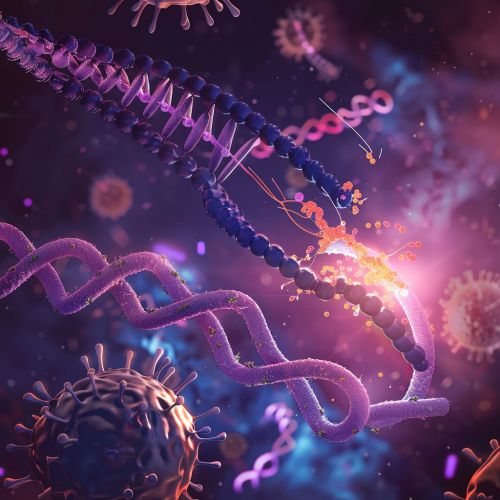Pre-mRNA
Overview
Pre-mRNA, or precursor messenger RNA, is an immature single strand of messenger RNA (mRNA) synthesized from a DNA template in the cell nucleus. This molecule undergoes several processing steps before becoming mature mRNA, which can then be translated into a protein. The processing of pre-mRNA is a crucial step in the gene expression pathway, ensuring that the genetic information is accurately and efficiently converted into functional proteins.
Structure and Synthesis
Pre-mRNA is synthesized during the process of transcription by the enzyme RNA polymerase II. The DNA template is read in a 3' to 5' direction, and the pre-mRNA is synthesized in a 5' to 3' direction. The initial transcript includes both exons (coding regions) and introns (non-coding regions), as well as untranslated regions (UTRs) at both ends.


Processing of Pre-mRNA
Capping
The first modification of pre-mRNA is the addition of a 5' cap. This cap is a modified guanine nucleotide added to the 5' end of the pre-mRNA shortly after transcription begins. The 5' cap protects the nascent mRNA from degradation and assists in ribosome binding during translation.
Splicing
Splicing is the process by which introns are removed from the pre-mRNA and exons are joined together. This is carried out by a complex known as the spliceosome, which recognizes specific sequences at the intron-exon boundaries. The splicing process is highly regulated and ensures that only the necessary coding sequences are included in the mature mRNA.
Polyadenylation
At the 3' end of the pre-mRNA, a poly(A) tail is added. This process, known as polyadenylation, involves the cleavage of the pre-mRNA downstream of a specific sequence (AAUAAA) and the addition of a long stretch of adenine nucleotides. The poly(A) tail enhances the stability of the mRNA and aids in its export from the nucleus to the cytoplasm.
Alternative Splicing
Alternative splicing is a mechanism by which different combinations of exons are joined together to produce multiple mRNA variants from a single pre-mRNA transcript. This process allows for the generation of diverse protein isoforms from a single gene, significantly increasing the complexity of the proteome. Alternative splicing is regulated by various splicing factors and is influenced by the cellular environment and developmental stage.
Regulation of Pre-mRNA Processing
The processing of pre-mRNA is tightly regulated by a network of RNA-binding proteins and small nuclear RNAs (snRNAs). These factors interact with the pre-mRNA and the splicing machinery to ensure accurate and efficient processing. Dysregulation of pre-mRNA processing can lead to various diseases, including cancer and neurodegenerative disorders.
Clinical Implications
Mutations or defects in the splicing machinery or in the sequences of pre-mRNA can result in aberrant splicing, leading to the production of dysfunctional proteins. Such splicing defects are implicated in several genetic disorders, including spinal muscular atrophy and certain types of cancer. Understanding the mechanisms of pre-mRNA processing has important implications for the development of therapeutic strategies.
Research and Future Directions
Ongoing research in the field of pre-mRNA processing aims to elucidate the detailed mechanisms of splicing regulation and the role of alternative splicing in health and disease. Advances in high-throughput sequencing technologies and bioinformatics are providing new insights into the complexity of the transcriptome and the regulation of gene expression.
